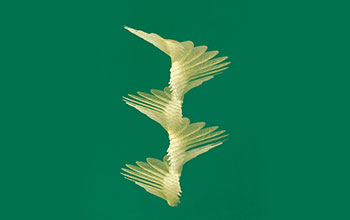Multimedia Gallery
"DNA of Maple Seed Flight"
"DNA of Maple Seed Flight," by David Lentink, Wageningen University.
The autorotating flight path of a maple seed is visualized here in a composite, multiflash photo. The seed exhibits a DNA-like flight spiral.
In trying to determine how the seeds of maple trees descend so slowly, Lentink and colleagues found that by swirling, maple seeds generate a tornado-like vortex that sits atop the front leading edge of the seeds as they spin slowly to the ground. This leading-edge vortex lowers the air pressure over the upper surface of the maple seed, effectively sucking the wing upward to oppose gravity, giving it a boost. The vortex doubles the lift generated by the seeds compared to nonswirling seeds. Lentink's research was published in Science (June 12, 2009); this photo appeared on the cover.
This image was entered for judging in the Photography category of the 2009 International Science & Engineering Visualization Challenge (SciVis) competition, sponsored by the National Science Foundation and the journal Science. The competition is held each year to celebrate the grand tradition of science visualization and to encourage its continued growth. The spirit of the competition is to communicate science, engineering and technology for education and journalistic purposes. To learn more about the competition and view all the winning entries, see the NSF SciVis Special Report.
This research was supported by a grant from the National Science Foundation (IBN 02-17229). For more information on Lentink's research related to this photo, see the Caltech news story Maple Seeds and Animals Exploit the Same Trick to Fly. (Date of Image: May 2009)
Credit: David Lentink, Wageningen University
Special Restrictions: This image is copyright and is available for personal, education, and nonprofit/noncommercial use only. The photo is available for commercial use through the journal Science's photo library at http://www.sciencephoto.com/media/98383/view.
Images and other media in the National Science Foundation Multimedia Gallery are available for use in print and electronic material by NSF employees, members of the media, university staff, teachers and the general public. All media in the gallery are intended for personal, educational and nonprofit/non-commercial use only.
Images credited to the National Science Foundation, a federal agency, are in the public domain. The images were created by employees of the United States Government as part of their official duties or prepared by contractors as "works for hire" for NSF. You may freely use NSF-credited images and, at your discretion, credit NSF with a "Courtesy: National Science Foundation" notation.
Additional information about general usage can be found in Conditions.
Also Available:
Download the high-resolution JPG version of the image. (10.1 MB)
Use your mouse to right-click (Mac users may need to Ctrl-click) the link above and choose the option that will save the file or target to your computer.



